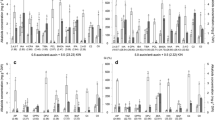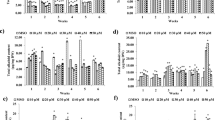Abstract
Effect of synthetic analogs of auxins—2.4-dichlorophenoxyacetic (2.4-D) and α-naphthylacetic (α-NAA) acids—on growth characteristics and accumulation of steroidal glycosides was investigated in suspension cell culture of Tribulus terrestris L. It was found that the substitution of α-NAA for 2.4-D in the nutrient medium brought about a rise in the content of steroidal glycosides in the cultured cells (up to six times) and broadened their structural diversity (nine identified oligofurostanosides when growing culture on the medium with α-NAA vs. five compounds on the medium with 2.4-D). Positive influence of α-NAA exerted on biosynthetic characteristics of T. terrestris suspension cell culture was accompanied by changes in cell morphology (cytodifferentiation), the extent of their aggregation, and gradual decrease (during 3–4 cycles of growing) in culture viability up to its extinction. Simultaneous presence of both synthetic analogs of auxins (α-NAA and 2.4-D) in the growing medium also caused a rise in the content of steroidal glycosides in the cells of T. terrestris, although it was less pronounced (up to three times); however, the culture showed a relatively steady growth and great viability in this case. It was concluded that these two auxin analogs differently influenced the growth of plants’ cells in vitro and biosynthesis of substances of specialized metabolism, 2.4-D promoted cell proliferation, whereas α-NAA induced cytodifferentiation and activated the production of secondary compounds. This conclusion is corroborated by the data concerning plant cell cultures of other species of medicinal plants accumulating secondary metabolites from other groups. For instance, in the experiments with suspension cell culture of Panax ginseng C.A. Mey., substitution in the growth medium of α-NAA for 2.4-D brought about a rise in the content and diversity of triterpene glycosides (ginsenosides) associated with an elevated cell aggregation and deterioration of culture’s viability. Comparison of production of steroidal glycosides in plant cell cultures of T. terrestris and Dioscorea deltoidea Wall. that is grown for more than 40 years has shown that both cultures accumulated only furostanol (rather than spirostanol) glycosides that promoted cell proliferation. In suspension cell culture of Dioscorea, a high level of oligofurostanosides (up to 12% of dry biomass) was accumulated when growing culture on the medium with 2.4-D. Thus, investigation into the production of furostanol glycosides in plant cultured cells points to a multifactor system of regulation of secondary metabolism in vitro. Different synthetic auxin analogs may exert alternative influences on growth and biosynthetic processes. At the same time, prolonged culturing leads to an autoselection of cells with the properties promoting proliferation, specifically, with a high content of furostanol glycosides.







Similar content being viewed by others
REFERENCES
Nosov, A.M., Popova, E.V., and Kochkin, D.V., Isoprenoid production via plant cell cultures: biosynthesis, accumulation and scaling-up to bioreactors, in Production of Biomass and Bioactive Compounds Using Bioreactor Technology, Paek, K.Y., Murthy, H.N., and Zhong, J.J., Eds., Dordrecht: Springer, 2014, p. 563.
Smolenskaya, I.N., Reshetnyak, O.V., Smirnova, Yu.N., Chernyak, N.D., Globa, E.B., Nosov, A.M., and Nosov, A.V., Opposite effects of synthetic auxins, 2,4‑dichlorophenoxyacetic acid and 1-naphthalene acetic acid on growth of true ginseng cell culture and synthesis of ginsenosides, Russ. J. Plant Physiol., 2007, vol. 54, p. 215.
Kostova, I. and Dinchev, D., Saponins in Tribulus te-rrestris—chemistry and bioactivity, Phytochem. Rev., 2005, vol. 4, p. 111.
Angelova, S., Gospodinova, Z., Krasteva, M., Antov, G., Lozanov, V., Markov, T., Bozhanov, S., Georgieva, E., and Mitev, V., Antitumor activity of Bulgarian herb Tr-ibulus terrestris L. on human breast cancer cells, J. BioSci. Biotechnol., 2013, vol. 2, p. 25.
Al-Bayati, F.A. and Al-Mola, H.F., Antibacterial and antifungal activities of different parts of Tribulus te-rrestris L. growing in Iraq, J. Zhejiang Univ. Sci. B., 2008, vol. 9, p. 154.
Erhun, W.O. and Sofowora, A., Callus induction and detection of metabolites in Tribulus terrestris L., J. Plant Physiol., 1986, vol. 123, p. 181.
Nikam, T.D., Ebrahimi, M.A., and Patil, V.A., Embryogenic callus culture of Tribulus terrestris L. a potential source of harmaline, harmine and diosgenin, Plant Biotechnol. Rep., 2009, vol. 3, p. 243.
Khandy, M.T., Kochkin, D.V., Tomilova, S.V., Galishev, B.A., Sukhanova, E.S., Klyushin, A.G., Ivanov, I.M., and Nosov, A.M., Obtaining and study of callus and suspension plant cell cultures of Tribulus te-rrestris L., a producer of steroidal glycosides, Appl. Biochem. Microbiol., 2016, vol. 53, p. 800.
Tomilova, S.V., Kochkin, D.V., Galishev, B.A., and Nosov, A.M., Effect of elevated concentrations of copper ions on growth characteristics and synthesis of steroidal glycosides in suspension plant cell culture of Tribulus terrestris L., Biotekhnologiya, 2019, vol. 35, p. 42.
Murashige, T. and Skoog, F., A revised medium for rapid growth and bio-assays with tobacco tissue cultures, Physiol. Plant., 1962, vol. 15, p. 473.
Nosov, A.M., Methods for evaluation and characterization of plant cell culture growth, in Molekulyarno-geneticheskie i biokhimicheskie metody v sovremennoi biologii rastenii (Molecular Genetic and Biochemical Methods in Modern Plant Biology), Kuznetsov, Vl.V., Kuznetsov, V.V., and Romanov, G.A., Eds., Moscow: Binom, Laboratoriya Znanii, 2012, p. 386.
Zheng, W., Wang, F., Zhao, Y., Sun, X., Kang, L., Fan, Z., Qiao, L., Yan, R., Liu, S., and Ma, B., Rapid characterization of constituents in Tribulus terrestris from different habitats by UHPLC/Q-TOF MS, J. Am. Soc. Mass Spectrom., 2017, vol. 28, p. 2302.
Mulinacci, N., Vignolini, P., la Marca, G., Pieraccini, G., Innocenti, M., and Vincieri, F.F., Food supplements of Tribulus terrestris L.: an HPLC-ESI-MS method for an estimation of the saponin content, Chromatografia, 2003, vol. 57, p. 581.
Hamed, A.I., Janda, B., Mahalel, U.A., Stochmal, A., and Oleszek, W., Profiles of steroidal saponins from the aerial parts of Tribulus pentandrus, T. megistopterus subsp. pterocarpus and T. parvispinus by LC-ESI-MS/MS, Phytochem. Anal., 2012, vol. 23, p. 613.
Campanoni, P. and Nick, P., Auxin-dependent cell division and cell elongation. 1-Naphthaleneacetic acid and 2,4-dichlorophenoxyacetic acid activate different pathways, Plant Physiol., 2005, vol. 137, p. 939.
Nosov, A.M., Application of cell technologies for production of plant-derived bioactive substances of plant origin, Appl. Biochem. Microbiol., 2012, vol. 48, p. 609.
ACKNOWLEDGMENTS
This work was supported by the Russian Science Foundation, project no. 19-14-00387.
Author information
Authors and Affiliations
Corresponding author
Ethics declarations
COMPLIANCE WITH ETHICAL STANDARDS
This article does not contain any studies involving animals or human participants performed by any of the authors.
CONFLICT OF INTEREST
The authors declare that they have no conflict of interest.
Additional information
Translated by N. Balakshina
Abbreviations: FG—furostanol glycosides; UPLC ESI MS—ultra-high performance liquid chromatography coupled with electrospray ionization mass spectrometry.
Rights and permissions
About this article
Cite this article
Tomilova, S.V., Khandy, M.T., Kochkin, D.V. et al. Effect of Synthetic Auxin Analogs (2.4-D and α-NAA) on Growth and Biosynthetic Characteristics of Suspension Cell Culture of Tribulus terrestris L.. Russ J Plant Physiol 67, 636–645 (2020). https://doi.org/10.1134/S1021443720040172
Received:
Revised:
Accepted:
Published:
Issue Date:
DOI: https://doi.org/10.1134/S1021443720040172




